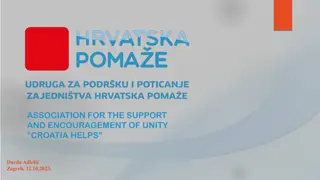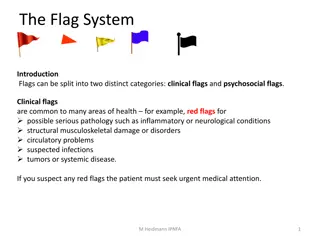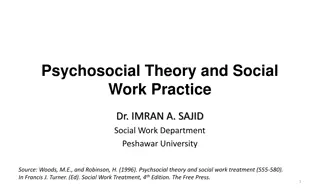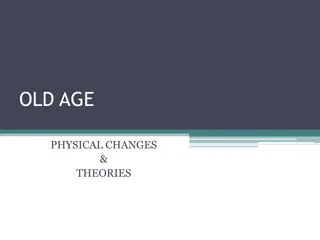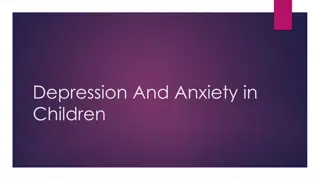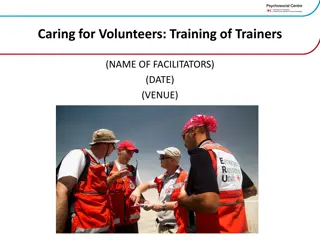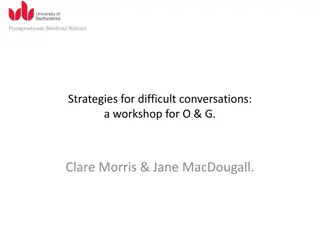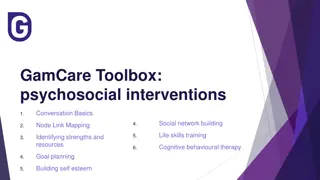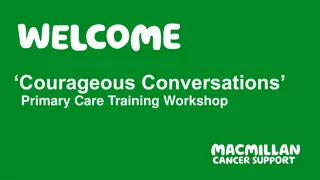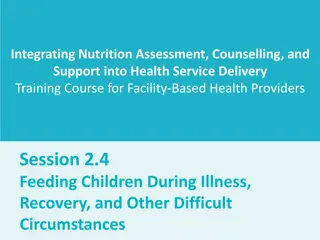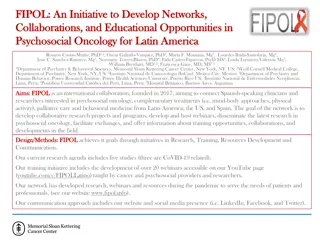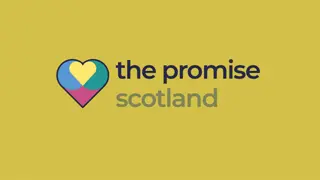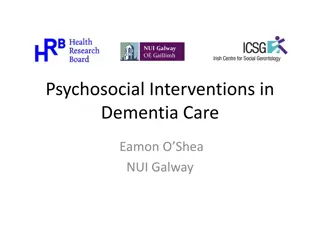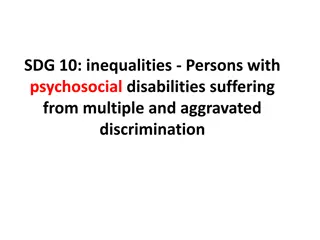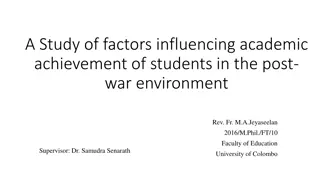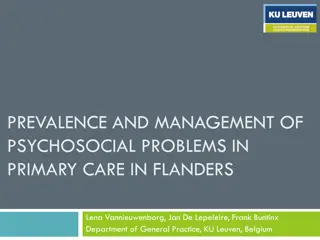Psychosocial Care Training Workshop for Children in Difficult Circumstances
This training workshop focused on understanding children's psychosocial issues, linking child protection with psychosocial care, and developing essential skills for providing supportive care to children in challenging situations. Participants engaged in various interactive learning methods, including role plays, case studies, and group activities. The importance of reconnecting with one's own childhood experiences and understanding the impact of traumatic events on child development were key themes explored during the workshop.
Download Presentation

Please find below an Image/Link to download the presentation.
The content on the website is provided AS IS for your information and personal use only. It may not be sold, licensed, or shared on other websites without obtaining consent from the author.If you encounter any issues during the download, it is possible that the publisher has removed the file from their server.
You are allowed to download the files provided on this website for personal or commercial use, subject to the condition that they are used lawfully. All files are the property of their respective owners.
The content on the website is provided AS IS for your information and personal use only. It may not be sold, licensed, or shared on other websites without obtaining consent from the author.
E N D
Presentation Transcript
Basic Psychosocial Care for Children in Difficult Circumstances Training Workshop Child Welfare Committee, Karnataka December 2017/ June 2018 Community Child & Adolescent Mental Health Service Project Dept. of Child & Adolescent Psychiatry NIMHANS, Bangalore In Collaboration with Dept. of Women & Child Development, Government of Karnataka1
Our Learning Objectives Understanding children s psychosocial issues. Linking child protection and psychosocial care, including understanding issues of abuse and trauma. Skill building with a focus on: Getting started with children. Developing basic communication skills to facilitate supportive care worker-child relationships. 2
Our Learning Methods Slides/ materials Do-and-learn (skills) Role Plays Case-Studies Participatory Group Activities and Discussion 3
I. Children & Childhood 4
Re-Connecting with Your Childhood Activity: Close your eyes and remember your childhood days. Re-visit people, places, events that occurred then. Share your childhood memory with the group Repeat the process (of closing eyes and then group sharing) by re-visiting memories of: difficult childhood experiences traumatic childhood experiences. 5
Discussion: How did you feel when you re-visited happy memories versus difficult and traumatic ones? Who helped/ how did you cope? The importance of being in touch with your own childhoods so you know what it is like to be a child, what makes children happy, angry or sad. How this sensitivity is essential to working effectively with children. The importance of being aware of one s own feelings and emotions- so that one may also understand another s feelings and emotions better. The impact of memories how childhood events still impact us in adult life. 6
Identifying Child Developmental Needs & How They are Impacted by Difficult Circumstances Activity 1: Objectives: To identify children s physical, social, speech & language, emotional and cognitive needs. To understand how these developmental needs are impacted by difficult circumstances. 7
Key Areas for Child Development Physical Emotional Cognitive Social Language 8
Process (a): Divide into 5 sub-groups. Round 1: Sort cards into 5 domains of development. (Each group picks up cards relevant to their domain). Round 2: Within each domain, sort cards for abilities & skills to match needs and opportunities. (Within each group, after initial round of sorting, further categorize and match the cards). View the categorization in plenary discuss. Generate ideas/ activities to further child development in each domain physical, social, speech and language, emotional & cognitive areas. What types of activities can we do/ do you do? Let us develop a list 9
Physical Development (1) Abilities & Skills Needs & Opportunities Social Development (2) Abilities & Skills Needs & Opportunities Speech & Language Development (3) Abilities & Skills Needs & Opportunities Emotional Development (4) Abilities & Skills Needs & Opportunities Cognitive Development (5) Abilities & Skills Needs & Opportunities 10
Lets Talk about Attachment Nature of the bond between child and care-giver Usually, attachment figure is mother (sometimes there can be extended attachments) Strong attachment is related to security and well-being Loss of attachment figure (through loss or separation) can give rise to insecurity and related anxiety problems clinginess and expectation. Contexts/ Situations where child is at risk of insecure attachment: Children in intact families Parental conflict Neglect Non-response to child s needs Physical/ sexual abuse Frequent separation experiences. Children in conflict areas: Abandoned/orphaned Suffering loss in conflict areas, Institutional upbringing, Frequent change of care takers 11
Physical Development Abilities/ Skills Needs 0 to 6 years: Gross Motor Skills: mobility, ability to handle objects Fine Motor Skills: pre-writing skills, transfer functions, eye-hand coordination Physical skills necessary self- help: buttoning, brushing, feeding etc. General growth and nutrition Physical activities/ play/ exercise Sensory experiences Fine-motor activities such as beading, colouring, buttoning Ages 7+: Continued physical growth Full independence in self-care. Fine motor tasks easily achieved. General growth and nutrition Physical activities/ play/ exercise Ages 13 to 18: Development of secondary sexual characteristics. Menstruation in girls. Preparation for bodily changes/ education/ awareness. 12
Language Development Abilities/ Skills Needs 0 to 6 years: Increase fund of words. Ability to construct short sentences. Express needs. Ability to describe. Naming and pointing games Story telling Phone games Describing games (using pictures or real life observations/events or television clips) Concept book/ flash cards 7 to 12 years: Language used for higher levels of communication to report experiences. Ability to communicate needs and experiences. Opportunities to describe, to be heard, to share experiences. Freedom to communicate needs. 13 to 18 years: Language used for complex social transactions, incl. life skills like refusal skills/ assertive skills/ negotiation. To process complex feelings and relationship dynamics. To articulate opinions and choices. 13
Social Development Abilities/ Skills Needs 0 to 5 years Recognizing familiar people Understanding rules of play Peer interaction Understanding of spaces (and what happens there) Understanding of sequences and routines Simple rule-based games Naming and pointing familiar people Naming and pointing familiar spaces/ places where child goes + discussion about what is done there Supervised peer interaction, group play, cooperative play (exposure to playgrounds/ play spaces) Use of pictures to explain day s routine/ sequencing 7 to 12 years Development of gender identity Pretend/ imaginative play, group play Same sex/ peer-group play Opportunities for peer group play, forming friendships, Comfort/ security sense of belonging to peer group/ school/ family Affirmative sense of identity 13 to 18 years Development of sexual interests/ orientation. Peer group interactions all important. (need to fit in ). Self-identity/ individuality. Questioning parental/ adult authority. Rules and healthy boundaries, along with opportunities to practice independent decision- making skills. Relationship satisfaction. Clarity on future orientation 14
Emotional Development Abilities/ Skills Needs 0 to 6 years: Attachment and bonding Ability to identify emotions Ability to regulate emotions (responsiveness to soothing/ distress states not prolonged/ separation from attachment figure) Ability to recognize emotional state of another person and ascribe simple reasons to causality Differentiating between positive and negative emotions Providing frequent and timely responses of love/ affection to child, incl. positive feed-back, verbal and non-verbal. Identifying emotions through pictures Story telling Story completion Visual analogue (emotion scale) Listing situations in which a certain emotion is felt ( you are happy when ) 7 to 12 years: Emotional regulation (anger/ anxiety control in context of conflict/ provocation) Ability to report emotional states. Development of empathy. Ability to provide positive emotional response (reassurance/ comfort) Provide disclosive sharing spirit/ opportunity. Opportunities to acknowledge and process intense emotions such as emotions and fear. Appreciation, encouragement Pro-social behaviour opportunities 13 to 18 years: Ability to cope with stress. Developing and making decisions about attraction/ intimate/ sexual relationships. Dealing with peer pressure. Greater need to establish self-identify, independence. Family, school, social support. Life skills negotiation, assertiveness, stress & coping, problem solving Resilient handling of role task, relational & emotional challenges Happy, healthy, responsible sexual behaviour 15
Cognitive Development Abilities/ Skills Needs 0 to 6 years: Fund of information Knowledge of use of objects Ability to form associations Ability to form categories Sequencing and organizing abilities Ability to understand concepts such as shape, size, distance, directions Puzzles Identification of colors, shapes Story telling (including discussions) Story Completion Use of pictures for sequencing events/ stories Play to demonstrate use of objects Attention enhancing tasks (joining dots, spotting the difference, eye-hand coordination activities) Concept book/ flash cards 7 to 12 years: Learn the difference between right and wrong . Ability to think and reason from concrete visible events. Play more complex rule-based games. Conversations, debating on real life situations and television images, discussions on existing social realities, including inequity. Story-telling, drama. (More complex themes for adolescents: gender, sexuality, abuse, risk behaviours, conflict resolution ) 13 to 18 years: Less likely to accept what is stated by others/ more likely to question. Creative thinking/Abstract abilities can generalize from specific situations. Ability for self-introspection, analysis, judgement. 16
Process (b): Consider the five domains of child development how are the abilities and skills of children in difficult circumstances impacted? How is their access to activities and opportunities impacted? 17
Understanding Children s Emotional & Behavioural Problems Context: Home/ School/ Family/ Public Space/ Social Spaces Basis of Understanding Child/ Basis of Counsellor s Response & Intervention Impact on Child: Emotions/ Behaviours Child s Experience: Happy/Difficult/ Traumatic (Loss/ Abuse) 18
Identifying Emotional/ Behaviour Problems & Contexts Case 1: A 15-year old girl has suicidal thoughts, refuses to eat and has disturbed sleep, she is often seen crying, has recurrent disturbed images of her past. She lost her mother a year ago, after which her father has re-married. He no longer wanted to be responsible for her, so she was married off to a 30-year old man, who sexually abused her multiple times; she was also beaten/ burnt on various parts of her body by her mother-in-law. Case 2: A 14 year old girl, was rescued by Childline team from the streets where she had lived for about 2 years. Her mother had died when she was 5 yrs old; although she was sent home, her father refused to take her in (he was re- married) when the family was tracked and none of her relatives wanted her. So she ran away again. This time around she lived with a transgender person (who was in sex work) for a year. This person wanted to keep the child safe and brought her to CWC/ institution. The child now shows a lot of anger/ aggression behaviours; she does not obey anyone; she has lying and stealing problems. No institution is able to manage her & they don t want her. 19
Case 3: A 10 year old girl spends all his time alone, does not eat properly and has sleep problems. She has no friends and is often in his own world ( lost ). She also has academic problems. She was sexually abused by her father and brother; her father killed her mother. Case 4: A 14 year old girl is always angry and aggressive, but also has a tendency to be very clingy i.e. if a person she has befriended someone, she does not like her to engage with any other children/ people. Her mother died when she was about 10 years old. She was on the streets from the age of 8, begging, as parents were alcohol dependent and did not take care of the child. She still misses her mother very much and says that had she known about her mother s hospitalization, she could have saved her (it s my fault that my mother died). 20
Case 5: A 14 year old boy is often angry, gets into fights with other children, breaks window panes, and does not adhere to the rules of the institution. Previously, he was part of gangs and into smoking. The child had lost his father; his mother re-married and he was physically abused by his step father who also made him discontinue school and work at a cycle shop. The step-father is also into gangs and physically abuses the child s mother. Case 6: A 11 year old boy was reported by the institution to have anger issues -- hitting and biting other children as well as runaway behaviour. The child was sent to a hostel by his grandmother and he ran away from the hostel twice because he was beaten there. There is marital discord in the family : mother has re-married and she resides in Hassan, the child does not wish to stay with his mother as he reports that beats him and makes him sleep outside the house/ does not give him food. The child s biological father resides in another town with his family , the child has better relationship with his father but the father has alcohol dependence and he does not wish to take the responsibility of the child. 21
Developing Basis for Response: Understanding the Child Experience (Happy/ Difficult/ Traumatic ) Context (orphan/ abandoned/ma rital conflict/single parent/HIV+/do mestic violence ) Emotions (anxious, sad, angry ) Behaviours (bed-wetting, isolated, verbal abuse ) Child s Inner Voice/Though ts ( I am ) 22
II. Communication Techniques with Children Rapport Building Listening Recognition & Acknowledgement of Emotions Acceptance & Non-Judgemental Approach Questioning & Paraphrasing 23
Skill 1: Getting to Know the Child Rapport Building: First stage of building a relationship with the child. 3 steps to rapport building get to know the child Step 1: Greeting the Child Step 2: Preliminary Establishment of Context Step 3: Let s get to know each other (activities) 24
Step 1: Introducing yourself (as CWC member/ childcare worker) Greeting Greet the child. Shake hands if appropriate. Tell her your name and ask her s. Introducing yourself/ your role There are many children (like you) who have problems and difficulties, at home or outside. My job is to work with such children and see how best to solve the problems. As you can see/ you may have heard, we have a committee to help children when they get hurt or have problems. I am part of this committee. I would like to know more from you, about what you see as problems, so that I understand better how to assist you and whatever plans and decisions are to be made for you, I/ this committee will make along you in consultation with what your wishes. 25
Step 2: Preliminary Establishment of Context Establishing child s knowledge and understanding: I am aware of the difficult experience you have gone through. Would you like to tell me anything about it your concerns and worries about it? Universalizing the child s experience: Like you, other children, have had similar, difficult experiences. Some of them are frightened and upset and need help with what they are feeling and experiencing just like you might . Individualize the child s experience: In response to what the child may say about why he/ she is with you: While other children may have gone through such an experience--similar to your s,--your experience is personal and specific to you. Everyone needs help in different ways. I am here to understand and support you. Ensuring Confidentiality I want you to also know that when we talk or play, whatever we share will be between us. I won t tell anyone about your feelings or upsets. If there is a time/ a need to have to tell some of it to other people, I will only do it after consulting you and getting your permission never without. (Assuming that CSA has already been reported). 26
Step 3: Lets get to know each other Ask child neutral, non-threatening questions to elicit information about his/ her likes/ dislikes and interests: What did you eat today?/What have you been doing all morning? Flip a coin: The counselor and the child each choose heads or tails of a coin. When the coin is flipped, depending on what comes up, the person has to reveal a personal detail i.e. if the counselor chose heads and heads comes up, she must reveal a fact about herself; if tails comes up, it is the child s turn to reveal a fact about herself. Example: Blue is my favorite colour , or my favourite food is . Establish a spirit of collaboration Do an activity together drawing/ coloring, a puzzle, reading a story anything that interests the child. 27
Activity 1: Getting to Know the Child Objective: To learn to build rapport with the child. Process: Role play in pairs Introduce yourself to the child Establish context of interaction. Get to know each other better Discussion: Volunteers? What did we do right? What elements of the 3 steps were we able to implement? 28
Skill 2: Listening and Interest Reflective Listening/ Verbal response: Ok Hmm Alright Yes Attentive listening: Maintaining eye contact Nodding of the head Body posture like leaning forwards towards the child. Empathetic gestures like supportive pat on the shoulder or hand. 29
Appropriate Body Language: Attentive but relaxed sitting posture (no slouching/ drooping). No fidgeting. No writing notes/ doing other activities. No looking elsewhere/ poor eye contact. DO Show interest. Be empathetic and understanding. Demonstrate your interest through verbal and non-verbal cues. Listen for causes of the problem. Observe silence as appropriate. Listening Dos and Don ts DO NOT Argue. Interrupt. Be inattentive. Do other work. Pass judgment. Give advice immediately. Jump to conclusions. 30
Activity 2: Listening & Interest Objectives: Learning different ways of listening. Process: Divide into pairs. One member of each pair leaves the room and one stays in. Round 1: Group that is outside (when they re-join their partners) to talk for a minute continuously about some very important event in their lives to their partners. Instruct the group inside to sit with their fingers blocking their ears i.e. not to listen to their partners talking. Round 2: Group outside to talk for a minute about some very happy event in their lives tot heir partners. Instruct the group inside to look away, not make eye contact, not respond and act as if they are not listening. Round 3: Group inside and outside to talk non-stop to their partners. Neither should listen. Round 4: Group outside to share some very difficult experience in their lives with their partners. Instruct the group inside to be attentive, make eye contact, and express emotion. 31
Discussion: How the group outside felt during each round of the game? Various levels of listening i.e. from not listening at all (1) to hearing without listening (2) to talking so much that there is no listening (3) and finally active listening (4). In which round is good communication taking place? Why? 32
Skill 3: Recognizing and Acknowledging Emotions What are the ways in which we recognize and identify emotions? Non-verbal cues: facial expressions, gestures Verbal expressions: tone of voice, actual content of speech Other behaviours Of course we sympathize and we feel for the child but how do we show it? Non-verbal cues (holding hands, facial expressions, hugging ) Verbal expressions ( tone of voice, I know it must have been difficult it seems like you are really hurt and angry NO judgement of emotions expressed! Emotions are neither good nor bad they just are and we feel them, no matter that. It is alright for you to feel angry and frustrated 33
Activity 3: Recognizing and Acknowledging Emotions Objective: How to identify and recognize emotions. How to communicate to a child that you recognize & acknowledge his/her emotions. Process: Divide into pairs. Read the children s expressions provided. Identify the emotions expressed. Next, one participant assumes role of child and the other that of PSS counselor. Use the dialogues of the children (below) and do the following: Role-play your response to the child. How will you respond to them? State your verbal response to show that you recognize and acknowledge the emotions felt by the child. Demonstrate non-verbal responses you would provide. 34
Childrens Narratives (Activity 3: Recognizing & Acknowledging Emotions) Saira, age 6 When I went to school and came back, my father was gone. No one knows where he went. My mother left me here [in the institution] but will she come back to see me? Puneet, age 8 My mother died a year ago then I went to my aunt and uncle s house and stayed there for sometime. They said my parents were bad people and that I was useless and just taking up space in the house they did not want me so they sent me here [to institution]. . Shekhar, age 10 Two years ago, I was sent to work as a helper in a shop to supplement the family income. The shop owner often yelled at me and hits me even for minor mistakes. But I cannot do anything because my family needs the little money that I earn. . Mamata, age 14: I feel scared all the time I cannot eat, I cannot sleep if I try to close my eyes, I see images of that man he is coming towards me and I know he is going to hurt me. 35
Skill 4: Non Judgemental Attitude & Acceptance What does non-judgemental attitude mean? Allowing the child to hurt herself in distress? Telling the child it is alright not to go to school if she does not feel comfortable? Assuring the child it is alright for him to feel very angry about the shop owner s abusing him? Acknowledging to the child that the store room can indeed by frightening? Non-judgemental attitude involves Recognizing and acknowledging a feeling/emotion WITHOUT being judgemental about whether that feeling is right or wrong . NOT giving your personal opinion in a way that is critical or blaming in any way. Accepting the child for who and what he/she is. 36
Activity 4: Non-Judgemental Attitude Objectives: To understand what non-judgemental attitude means. To reflect non-judgemental attitude in communication with children. Process: Read the two scenarios/conversations below between counselor & child. Discussion: What did the counselor do differently in scenario 2 versus scenario 1? Which do you think would be more effective in building a relationship with the child and why? How do you think the child would have responded/ said next in i) scenario 1; scenario 2? 37
Counsellor-Child conversations in a Child Care Institution: (Activity 4: Non-Judgemental Attitude) Scenario 1 Scenario 2 Child: I hate being here in this home! I don t want to stay here! I want to go back to my life on the street ! Counselor: Yes, it may be difficult for you to be here. But think about all those children who have been abused on the street such as you have Child: How do I know that I can be safe here? Counselor: Has anything happened here for you to feel unsafe? No, right? So, then why are you saying that? Child: I hate being here in this home! I don t want to stay here! I want to go back to my life on the street ! Counselor: Yes, it must be difficult for you it must make you angry to be in a place you dislike, where you don t have the freedom you are used to. But we are concerned about your safety Child: How do I know I can be safe here? Counselor: It is natural for you to feel insecure, given what you have gone through we will try to ensure that we identify a supervisor of your choice to assist you. 38
Counsellor-Adolescent conversations in the context of pregnancy (Activity 4: Non-Judgemental Attitude) Scenario 1 Scenario 2 Counselor: Did you know this person before you ran away with him? Adolescent: Yes, we were friends. Counselor: But he was so much older than you Adolescent: Yes, but he said he cared for me and that he would look after me. Counselor: Don t you know that girls should be careful? and it will be a problem if we just believe some man like that Child is silent. Counselor: And now you see what has happened girls should be careful about relationships and didn t you know about the dangers of HIV? Should you not think about your health? Counselor: Did you know this person before you ran away with him? Adolescent: Yes, we were friends. Counselor: Did you feel comfortable and confident being with him? Adolescent: Yes, he said he cared for me and that he would look after me. Counselor: Yes, I guess you trusted him. Sometimes we all can get manipulated. Child is silent. Counselor: Now that HIV has happened, we would like to help you carry out whatever decisions you want to take. I know this must be difficult and frightening for you but I assure you of our support to you. 39
Discussion: What did the counselor do differently in scenario 2 versus scenario 1? Which do you think would be more effective in building a relationship with the child and why? How do you think the child would have responded/ said next in i) scenario 1; scenario 2? Process (b): Divide (participants) into pairs and role play a conversation between counselor and child on the following issues: A 15 year old boy who sexually abused a 8 year old girl. A 16 year old girl who ran away with an older man and has just returned home, and found to test positive for HIV etc. 40
Skill 5: Questioning & Paraphrasing Closed ended questions: These type of questions lead to responses in monosyllables, which might not help explore what happened or encourage the child to talk about all the aspects and dimension of his/her situation. Useful to obtain precise details on date/ time/ no. of times an event happened/ who when only a single answer is possible. Leela : He behaved badly with me. Counselor: Did he touch you? Leela: Yes. Counselor: Did he touch you in your private parts? Leela: Yes. Counselor: Did you try to scream for help? Leela: Yes. Counselor: And did someone come to help you? Note: Close-ended questions are not wrong or unnecessary! Use them but to a lesser extent and in ways that will not block further information/ response. 41
Open ended questions: These types of question lead to elaborate answers that do not end in one word. Help to explore How and Why. (Descriptive where multiple answers are possible/ many details required). Leela : He behaved badly with me. Counselor: What happened? Leela: He touched me and made me uncomfortable. Counselor: Could you tell me a little more about that? Leela: He put his hands under my skirt and rubbed it. Counselor: What did you do then? Leela: I was so scared I tried to scream and then I ran from there Counselor: Sounds really scary. What happened next? 42
Paraphrasing: re-phrasing the content shared by the child to ensure and confirm that the counselor has not misinterpreted or missed out any information provided by the child. helps avoid incorrect inferences, conclusions and judgments being made by the counselor. Also allows for reflection of child s feelings about the experience. Example: It looks like he touched you on your private parts and made you really uncomfortable and scared. But you managed to scream for help and run away, despite being scared and that shows quick thinking and presence of mind. 43
Activity 5: Questioning & Paraphrasing Objectives: To learn when and how to use open and close-ended questions. To learn how to paraphrase what children express. Process (a): Open or Close Ended Question?? Convert it What happened yesterday? O so he hurt, you did he? How many times did he do that to you? When did these events happen? Who was the person who asked you to go with him? Can you identify the people who accompanied you to the railway station? Tell me more about how he hurt you What was your relationship with your mother like? Did you have a good relationship with your father? What are the things that make you angry? If someone shouts at you, do you get angry? Why do you feel anxious? Do you feel worried everyday? 44
Process (b): Divide into pairs. Assume role of child and counselor. Use the (children s) sentences below to practice exploring/understanding the issue with the child by asking i) close-ended questions; ii) open-ended questions and later paraphrasing: I hate what he did to me. I feel like killing him, am so angry I feel scared all the time if it will happen again Use the same sentences above to develop a communication with close-ended questions. Paraphrase your conversation with the child. Discussion: What was the difference between using open versus close-ended questions? Which one was helpful and why/ where? Why is paraphrasing important? 45
Film Screening Children of Heaven 46
II. Common Child Mental Health Problems
Why understand basic child mental health problems? To assess child growth and development. Identify developmental disabilities and common emotional and behaviour problems. To develop a care plan for the child. To be able to refer to specialized psychiatric care facilities (for medication and therapy as necessary).
Activity: Memory GameLearning about Common Child Mental Health Disorders Objective: To understand and learn the signs and symptoms of common mental health issues in children. Process: Divide into 5 groups (6 members in each group). Each team will be given 2 mins time to see and memorize all the symptoms of the mental health problem which is displayed. Later, each team will be given opportunity to recall all the symptoms which was displayed. The team which is able to recall all the symptoms correctly are awarded 10 points.
What is disability or developmental problem? Lack of skills/ abilities in one or more of the areas of child development. Delay in skills/ abilities in one or more of the areas of child development. Results in impaired day-to-day functioning of the child/ problems with activities for daily living.


